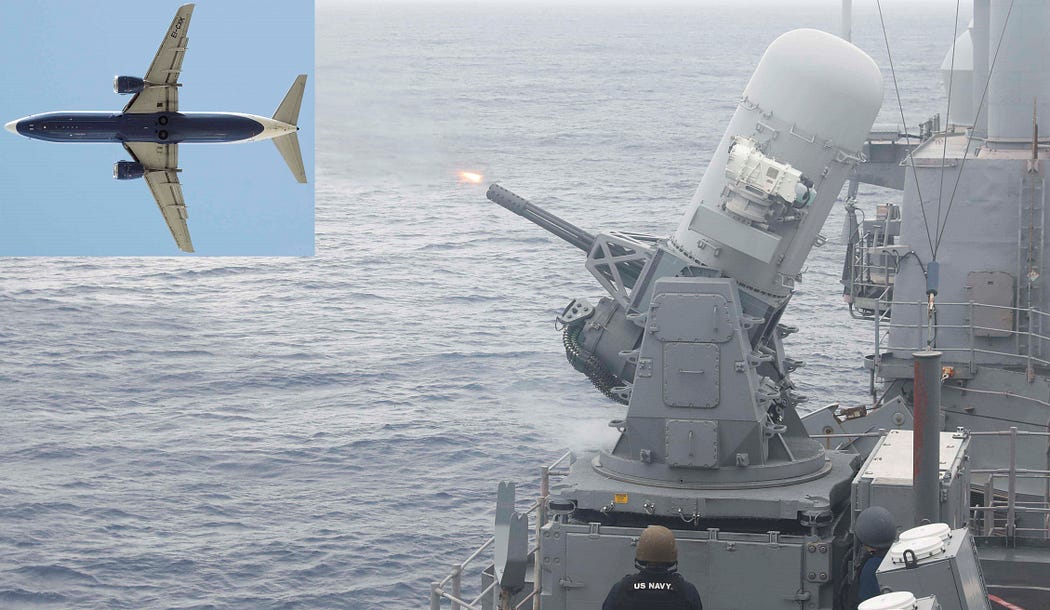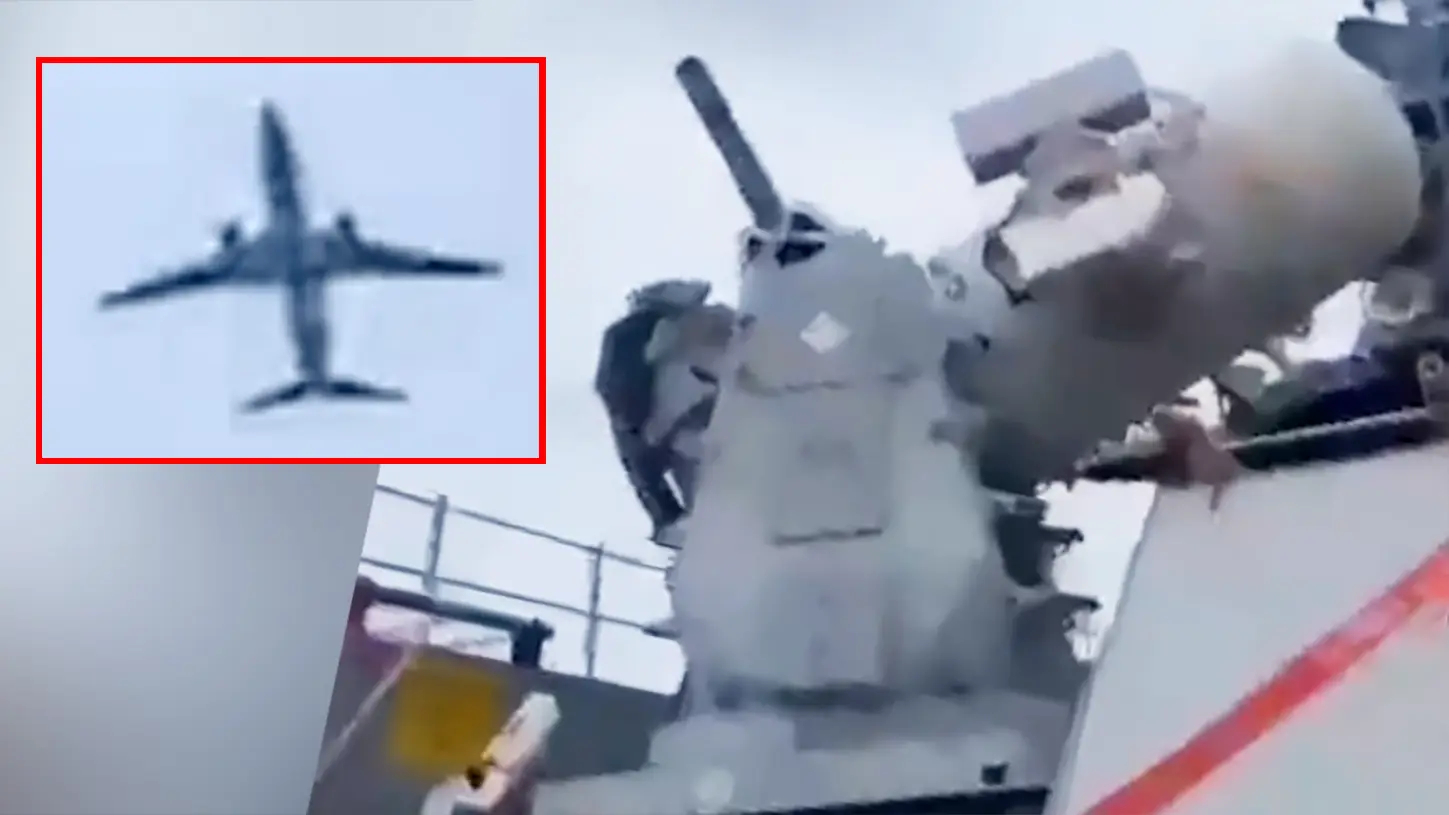A U.S. Navy Phalanx Gun Targeted a Civilian 737 This Week
In a video that went viral yesterday, you can see a Mk 15 Phalanx Close-In Weapon System (CIWS) begin to target what appears to be a civilian 737.
In an example of our collective dark sense of humor in the military, you can hear a sailor scolding the automated Phalanx as if it were a naughty toddler about to touch a hot stove.
It’s worth noting that this probably happens all the time. Ever flown into Reagan Washington National Airport (DCA)? Your plane was likely lit up like a Christmas tree.
The CIWS (often spoken as “sea-wiz”) in the video appears to be mounted on a U.S. Whidbey Island-class amphibious dock landing ship, although it could also be a Harpers Ferry-class.
According to the U.S. Navy, the CIWS is a fast-reaction, detect-through-engage, radar-guided, 20-millimeter gun weapon system. It’s used primarily as an inner layer of protection against anti-ship missiles (ASM), aircraft, and small boats that have penetrated other fleet defenses.
The weapon system has various modes, from fully manual, to semi-automated (where it needs approval to fire), to fully automated mode. In fully automated, the CIWS can engage targets as it sees fit, under certain conditions.
Over the years, the CIWS has undergone a number of upgrades to both its gun and its radar. Since 2015, the Navy has upgraded all Phalanx systems to the Block 1B variant.
Block 1B incorporates an automatic acquisition video tracker, optimized gun barrels (OGB), and Enhanced Lethality Cartridges (ELC) for additional capabilities against asymmetric threats such as small maneuvering surface craft, slow-flying planes and helicopters, and drones.
The CIWS has downed friendly aircraft before: In 1996, the Phalanx onboard the Asagiri-class Japanese destroyer JDS Yūgiri accidentally shot down a U.S. A-6 Intruder from the aircraft carrier USS Independence. The Intruder was towing a radar target during gunnery exercises about 1,500 mi (2,400 km) west of Oahu.
Both the pilot and navigator ejected safely.
In 2005, the U.S. Army started deploying a land-based version of the Phalanx, called the Centurion C-RAM, (for Counter-Rocket, Artillery, Mortar) to Iraq to protect U.S. bases from mortar attack. Unlike the naval variant, which fires tungsten armor-piercing rounds, the land variant fires 20–mm HEIT-SD (High-Explosive Incendiary Tracer, Self-Destruct) ammunition which greatly reduces collateral damage.
Still, there’s just something creepy about watching a Phalanx target a civilian airliner.
I don’t know about you, but the video seems to add to the general feeling of dread that we feel with each new AI announcement. While the CIWS is not technically AI-controlled, its fully automated functions do give it a real Terminator vibe.

Sailors Talk To Phalanx CIWS As It Targets A 737 Like A Dog About To Bite The Mailman
The Mk 15 Phalanx has experienced its share of personification, but telling it no like a dog is a hilarious and welcome new installment.
https://youtu.be/3_qSLR7a5qI?si=x1MRmOFytYQLoyqr
n what has to be one of the funniest and also creepiest military videos in some time, a Mk 15 Phalanx Close-In Weapon System (CIWS) is seen drawing a bead on a 737 passing over what appears to be a Harpers Ferry or Whidbey Island class amphibious dock landing ship. Sailors nearby laugh as they tell the sinister-looking Phalanx “No… No… NO!” as if it’s a dog about to do something it shouldn’t before it drops its barrel and forgets about the juicy target passing overhead.
Check out the viral video here:
The Mk 15 Phalanx is no stranger to personification. There have been endless jokes about its appearance and twitchy personality. From R2D2 to Frosty to an aroused Minion, Phalanx and its land-based cousin, Centurion, have brought some smiles.
As for any danger to the 737, which could have been a Navy P-8 Poseidon, although the markings don’t look that way, we just don’t know for sure. Regardless, there shouldn’t have been any real risk at all. The system has various modes, from fully manual, to semi-automatic where it needs approval to fire, to fully automatic mode. The latter of which allows it to engage targets as it sees fit in very specific combat situations.
Infamously, during Operation Desert Storm, a Phalanx operating in the fully automatic mode on the Oliver Hazard Perry class frigate USS Jarrett ended up spraying the Iowa class battleship USS Missouri with armor-piercing 20mm rounds after the battleship fired a Super Rapid Bloom Offboard Countermeasures (SRBOC) chaff canister while under threat from a Silkworm anti-ship missile attack. Thankfully, nobody was injured in that ‘blue on blue’ friendly fire incident and certainly other ‘Phalanx gone wild’ incidents have occurred.
The Mk 15 has been progressively upgraded over its decades of service and, in most configurations, it now features a host of electro-optical cameras to help visually identify targets before firing on them and to use the Phalanx’s 20mm cannon manually against small boats and other lower-end threats.
Still, that doesn’t mean it isn’t extremely creepy watching that Vulcan cannon slewing sinisterly on a hapless 737 overhead.
Thank goodness its masters were there to verbally command CIWS to ‘let it go.’ source

